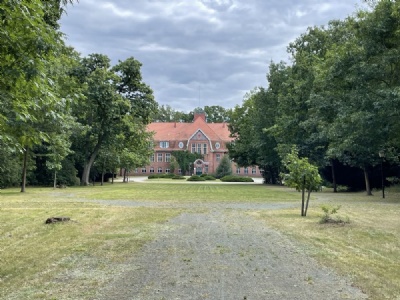Brandenburg – Görden
A continuation of the idea that man can be divided into different racial categories where "good" and "healthy" characteristics are meassured is race breeding. Better known as eugenics or genetic research, which means that you strive to protect the best genes in your own breed by distinguishing those who carried good genes from those who carried bad genes. What were defined as good and bad genes were arbitrary. Gene research was something that psychiatrists have been increasingly engaged in since turn of the twentieth century and believed that society should put in measures to protect the healthy people from the sick.
This meant that those who were diagnosed with incurable physical and mental disabilities should be interned, sterilized or even killed because their genes were considered to be harmful to the nation. If the inferior genes were given the opportunity to reproduce uninhibitedly, the psychiatrists considered that the nation faced an uncertain future that in the long run threatened the entire nation’s existence. These teachings were given a scientific legitimacy and began to spread outside psychiatric circles to politicians who began to investigate the possibility of statutory sterilizations of citizens that were considered harmful to the nation’s survival.
Nazi Germany was by no means the first and leading in psychiatric medicine but through Hitler, laws on forced sterilization of ”sick” adult citizens could be introduced in 1934. But psychiatrists wanted to go even further by simply removing these people, not just by internment or sterilization, but by killing them. However, this was quite different and it was understood that killing its own citizens would not only be accepted on the basis of some racial motives.
To give it legitimacy among people and circles who did not consent, it was argued that for reasons of mercy they should be allowed to die to avoid suffering. In addition, possible killings were justified by the fact that it was only a natural selection process in which the weaker elements of nature perished in favour of the stronger. But with the difference that the doctors became the self-appointed decision-makers about who was worthy life and who was unworthy of life. They also presented economic calculations of what people with disabilities who could not contribute to their own livelihood cost society.
At some thirty hospitals around Germany, special children’s wards (Kinderfachsabteilung) were established for children up to three years of age who had been diagnosed with, among other things, Down’s syndrome (or idiotism), deformed head shape, other deformities, epileptics, blindness, deafness, etc., but the age limit was raised shortly after up to sixteen years. The detention of sick children had begun unofficially in several hospitals in Germany already in 1938 but the first official Kinderfachsabteilung opened in July 1940 at the psychiatry clinic Brandenburg – Görden. The head of the clinic was Dr Hans Heinze and the head of Kinderfachsabteilung was Dr. Ernst Illing.
The first death from a mercy perspective was executed same month. Of approximately 4000 children who were hospitalized at Brandenburg – Görden’s Kinderfachsabteilung, 1270 were killed through starvation and lethal injections (luminal). All under the supervision of doctors and nurses who were convinced of the validity and necessity of their actions. By removing the inferior elements, they acted out of the good of humanity and showed humanity by helping the sick to a merciful death. In 1940, 430 children were sent to the euthanasia centre at the former Brandenburg prison, where they were murdered in a gas chamber. Between 1938 and 1944, a total of between 3,000 – 5,200 children were murdered at various Kinderfachsabteilungen.
Current status: Preserved with museum (2011).
Address: Anton-Saefkow-Allee 2, 14772 Brandenburg.
Get there: Car.
Follow up in books: Friedlander, Henry: The Origins of Nazi Genocide – From euthanasia to the final solution (1995).

The clinic is still a psychiatric clinic (Landesklinik Brandenburg) for children, adolescents and adults and there is a museum in the area. But the history of the clinic during Nazism is a sensitive subject for the clinic and they do not allow to photograph either the museum or the monument that is in the area without their approval. The reason is that much of the publicity that the clinic receives is its history and that people then make unintentional associations with the Nazi euthanasia. Publicity makes people see the clinic for what it once was and not for what it is today and this can create a negative feeling among patients and their relatives.